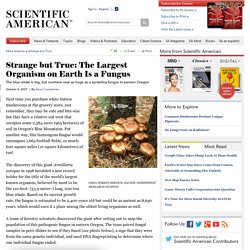

Strange but True: The Largest Organism on Earth Is a Fungus. Next time you purchase white button mushrooms at the grocery store, just remember, they may be cute and bite-size but they have a relative out west that occupies some 2,384 acres (965 hectares) of soil in Oregon's Blue Mountains.

Put another way, this humongous fungus would encompass 1,665 football fields, or nearly four square miles (10 square kilometers) of turf. The discovery of this giant Armillaria ostoyae in 1998 heralded a new record holder for the title of the world's largest known organism, believed by most to be the 110-foot- (33.5-meter-) long, 200-ton blue whale. Based on its current growth rate, the fungus is estimated to be 2,400 years old but could be as ancient as 8,650 years, which would earn it a place among the oldest living organisms as well. A team of forestry scientists discovered the giant after setting out to map the population of this pathogenic fungus in eastern Oregon. Both the giant blue whale and the humongous fungus fit comfortably within this definition.
Armillaria. As a forest pathogen, Armillaria can be very destructive.

It is responsible for the "white rot" root disease (see below) of forests and is distinguished from Tricholoma (mycorrhizal) by this parasitic nature. Its high destructiveness comes from the fact that, unlike most parasites, it doesn't need to moderate its growth in order to avoid killing its host, since it will continue to thrive on the dead material. In the Canadian Prairies (particularly Manitoba), the term "honey fungus" is unknown to many; due to the large presence of Ukrainian Canadians in this area, the fungus is often referred to as pidpenky (Ukrainian: підпеньки), from the Ukrainian term, "beneath the stump".
Description[edit] Grossly similar species include Pholiota spp. which also grow in cespitose clusters on wood and fruit in the fall. Plant pathology[edit] Honey fungus, a "white rot" fungus, is a pathogenic organism that affects trees, shrubs, woody climbers and, rarely, woody herbaceous perennials. Edibility[edit] Mushroom Pictures & Mushroom Reference. The Scariest Fungus on Earth. Difference between fungi and bacteria. FUNGI A fungus (plural fungi) is a eukaryotic organism that digests its food externally and absorbs the nutrient molecules into its cells.

Along with bacteria, fungi are the primary decomposers of dead organic matter in most terrestrial ecosystems. Many fungi have important symbiotic relationships with many other organisms. Mycorrhizal symbiosis between plants and fungi is particularly important; over 90% of all plant species engage in some kind of mycorrhizal relationship with fungi and are dependent upon this relationship for survival.
Fungi are also used extensively by humans: yeasts are responsible for fermentation of beer and bread, and mushroom farming and gathering is a large industry in many countries. The branch of biology involving the study of fungi is known as mycology. Fungi were originally classified as plants, however have since been separated as they are heterotrophs. The Fungi are a monophyletic group, meaning all varieties of fungi come from a common ancestor.